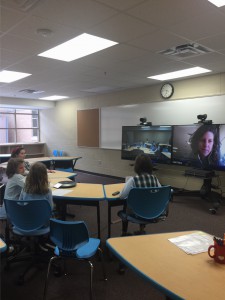February 18, 2016
 When I was a child, I vividly remember calling my grandparents on Sunday afternoons. They lived in the same state, but a couple of hours away, out in the country. We would each take turns unfurling the long, curly phone cord to tell them about our week, but only for a few minutes each, as we were admonished about the cost of long distance phone calls. The connection was often fuzzy, compelling the parties on either side of the line to shout, or at least speak unnaturally loudly, to carry our voices across the wire. Fast forward forty years to 2016 and we have a country in which most people carry phones in our pockets that connect us instantly, anywhere in the country, for a monthly fee, with relative clarity.
When I was a child, I vividly remember calling my grandparents on Sunday afternoons. They lived in the same state, but a couple of hours away, out in the country. We would each take turns unfurling the long, curly phone cord to tell them about our week, but only for a few minutes each, as we were admonished about the cost of long distance phone calls. The connection was often fuzzy, compelling the parties on either side of the line to shout, or at least speak unnaturally loudly, to carry our voices across the wire. Fast forward forty years to 2016 and we have a country in which most people carry phones in our pockets that connect us instantly, anywhere in the country, for a monthly fee, with relative clarity.
The stark contrast between 1970s America and 2016 was readily apparent this week in Mounds Park Academy’s virtual classroom. Renette Stinson’s third graders are preparing for their annual Parade of States by studying the various geographic regions in the United States. In order to get first-hand knowledge of these regions, they connected with alumna Juliet Dana (’05) in San Francisco. Juliet met them in a virtual classroom from the cafeteria at the University of California, Berkeley, where she is the Literacy Curriculum Developer at the Lawrence Hall of Science. The students ‘ooohed’ with delight as Juliet turned her computer to the window to show the bay, the San Francisco skyline, the local trees, and a distant Golden Gate Bridge. In real time, the students were able to ask Juliet questions about the climate, produce, and of course, earthquakes.
Next week, the first grade teaching team of Kari O’Keefe and Scott Wilson, along with Lower School Director Renee Wright, will connect with a specialist in New York for some professional development via the virtual classroom. In November, upper school Spanish teacher Kari Kunze taught her AP students from home while recuperating from knee surgery. The students reported to the virtual classroom and, with the press of a button, were able to connect with their teacher synchronously. Upper school students participating in the Malone Schools Online Network (MSON) have been taking advanced classes with students across the country in Medical BioEthics, Environmental BioEthics, Computer Graphics, Game Design and Animation, Arabic, and Philosophy: The Nature of Evil. They ask questions of their teachers and participate in conversations as though they were in the same physical space. Regardless of the nature of its usage, the virtual classroom has enabled instantaneous connections to be made across great distances in a way that was once costly and unclear.
As we move forward in the 21st century, it is exciting to anticipate the creative and technological advances that will enable greater connections between people and ideas. What we could once only conceptualize, we can now experience. Our students will experience the world differently than we have. At MPA, we embrace the opportunities to enable these connections for our students, whether they happen in the hallways or across a continent. We have come a long way from the long, curling phone cords of the 1970s, but the desire to reach out and connect with others is enduring.
I wonder what it will look like in another 40 years?